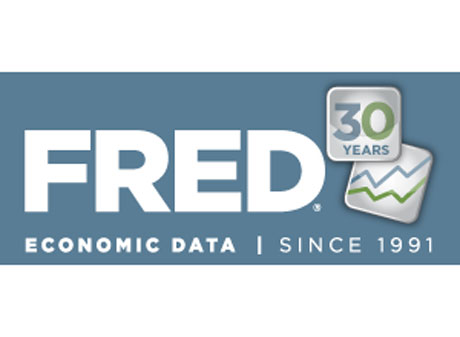FRED Database Marks 30th Anniversary

Turning 30 is a big milestone for anyone. It’s not quite as scary as turning 40, or as ponderous as turning 50, but the big 3-0 pretty much means you’re not a kid anymore. You’ve lived a little, you’ve seen a few things—and maybe it’s even time to take stock of where you’ve been.
So it goes for FRED, the signature economic database from the Federal Reserve Bank of St. Louis. Born on April 18, 1991, FRED is 30 years old. That’s right—FRED is a millennial, and all grown up!
FRED debuted with 30 data series—data whose changes over time are plotted on charts or reflected in spreadsheets. The data tool’s reach now spans the globe, with more than 788,000 data series and 6 million-plus users worldwide. ALFRED, which turns 15 in July, offers vintage, or unrevised, data in much the same way.
A Brief History of FRED

Homer Jones, St. Louis Fed research director from 1958 to 1971, created publications that were precursors to FRED.
FRED is a descendent of print data publications created by Homer Jones, the St. Louis Fed’s research director from 1958 to 1971, according to a history of FRED included in a special annual report marking the St. Louis Fed’s 2014 centennial.
“These paper data publications translated well to online posting,” according to the report. Although it’s difficult to imagine now, FRED (which stands for Federal Reserve Economic Data) began as a dial-up electronic bulletin board at the dawn of the internet age. At that time, web browsers were just being developed.
FRED now draws data series from many agencies, such as the Census, Labor Statistics and Economic Analysis bureaus in the U.S. Series are updated continuously and can even be accessed via smartphone using the FRED app. Since its inception, the database has been free to anyone who wants to use it.
What was the original intent of FRED, and why does the FRED team continue to invest in the data service? Katrina Stierholz, director of Research Information Services, addressed those questions in an article in the 2018 St. Louis Fed annual report.
FRED’s role is “to help citizens and businesses access data more easily and thereby make informed decisions,” Stierholz wrote.
Prices and Income When FRED Was Born
To put things in perspective, when FRED was born in April 1991, the median nominal price of a new home sold in the U.S. was $121,000. (See the chart below.)
That same year, the average American’s nominal mean personal income was $20,280 (adjusted for 2019 dollars) …
… and in April that year, the average nominal price of a gallon of gasoline was $1.08.
Nowadays, these numbers are all much higher: $349,400 (median home sales price), $54,129 (personal income) and $2.81 (gallon of gas), respectively, as of the latest observations on April 5.
Easy Access to Data

Our 2018 annual report is all about FRED and its family of information services. Read the essays, watch the interviews and find out what FRED enthusiasts have to say about how data access is important for decision-making.
So, how exactly do you find out what things cost at any given time, as shown above? Or what if you want to know about something more exotic, such as, say, brick production in 1785?
To find those answers, you could go to the original sources and search on their websites, if applicable. But the quickest, easiest way is to ask FRED. The database even has a series from the Bank of England that dates back to the year 1086. (For any history buffs out there, that’s 20 years after William the Conqueror defeated King Harold at the Battle of Hastings.)
Another helpful aspect of FRED is how it allows users to generate graphs on the spot without ever having to download any spreadsheets (unless, of course, they want to). And GeoFRED allows users to create, customize and share geographical maps of data found in FRED. Now that FRED is marking its 30th year, who knows what it will be able to do in the next 30? Here’s to many happy returns.
Editor's note: GeoFRED is sunsetting in 2022. You can now customize, share and download geographical maps of data directly in FRED Maps.
More to Explore:
- Open Vault: Economic Data Tracking Trends and New Tools
- Open Vault: How Much Did Something Cost the Year You Were Born?
This blog explains everyday economics and the Fed, while also spotlighting St. Louis Fed people and programs. Views expressed are not necessarily those of the St. Louis Fed or Federal Reserve System.
Email Us


